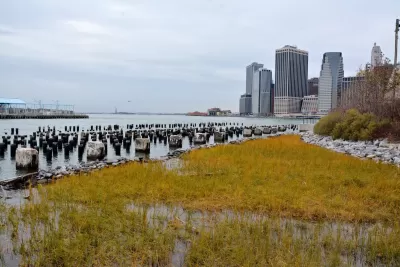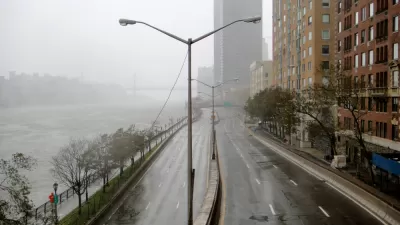After delays and a groundbreaking that still has not happened, proposed changes to New York’s big resiliency project have not been well received.

Danielle Muoio reports on the current status of the East Side Coastal Resiliency project, part of a larger plan called the Big U and funded by Rebuild by Design, a competition sponsored by the Department of Housing and Urban Development:
The intention was to add 2.2 miles of coastline that could absorb flooding in the event of a storm surge, but act as a park with jogging trails and other recreational activities on a day-to-day basis. It was expected to cost $760 million in total funding, with the city providing the additional $425 million.
The funds were awarded in 2014, and the project was scheduled to start in 2017. However, the de Blasio administration recently released a new plan that would cost significantly more, $1.45 billion, and change the design.
The new park would be raised, with a flood wall, and instead of extending to East 25th Street, it would end at East 13th Street. The administration says that under the revised plan’s schedule, the park would be finished 18 months sooner and construction could be shifted away from FDR Drive.
However, the plan raised questions about whether the new design would block East River views and about why the design is changing so late in the process. In addition, construction would not start until 2020, and concern has emerged about the future of other Big U projects.
FULL STORY: De Blasio administration pitches significant changes to East Side resiliency project

Planetizen Federal Action Tracker
A weekly monitor of how Trump’s orders and actions are impacting planners and planning in America.

Maui's Vacation Rental Debate Turns Ugly
Verbal attacks, misinformation campaigns and fistfights plague a high-stakes debate to convert thousands of vacation rentals into long-term housing.

Restaurant Patios Were a Pandemic Win — Why Were They so Hard to Keep?
Social distancing requirements and changes in travel patterns prompted cities to pilot new uses for street and sidewalk space. Then it got complicated.

In California Battle of Housing vs. Environment, Housing Just Won
A new state law significantly limits the power of CEQA, an environmental review law that served as a powerful tool for blocking new development.

Boulder Eliminates Parking Minimums Citywide
Officials estimate the cost of building a single underground parking space at up to $100,000.

Orange County, Florida Adopts Largest US “Sprawl Repair” Code
The ‘Orange Code’ seeks to rectify decades of sprawl-inducing, car-oriented development.
Urban Design for Planners 1: Software Tools
This six-course series explores essential urban design concepts using open source software and equips planners with the tools they need to participate fully in the urban design process.
Planning for Universal Design
Learn the tools for implementing Universal Design in planning regulations.
Heyer Gruel & Associates PA
JM Goldson LLC
Custer County Colorado
City of Camden Redevelopment Agency
City of Astoria
Transportation Research & Education Center (TREC) at Portland State University
Jefferson Parish Government
Camden Redevelopment Agency
City of Claremont





























